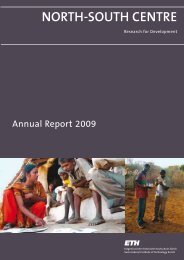Annual Report 2006/07 - ETH - North-South Centre North-South ...
Annual Report 2006/07 - ETH - North-South Centre North-South ...
Annual Report 2006/07 - ETH - North-South Centre North-South ...
Create successful ePaper yourself
Turn your PDF publications into a flip-book with our unique Google optimized e-Paper software.
Impact Studygrowing slowly or stagnating in industrialised countries. The“Livestock Revolution”, as this trend was defined when itemerged at the end of the 1990s, is determined by the globallyfast-growing middle classes who make their living in urbanand peri-urban areas and have new demands on food: Itshould contain more protein and micronutrients, be producedand marketed under hygienic conditions and take less time topurchase as well as to prepare.Parallel to the worldwide convergence of consumption patterns,the livestock production sector also shifts to developingcountries, the “Big Three” being Brazil, China and India.Livestock’s Long ShadowLivestock – in their numbers and in the present modes of production– enters direct competition for natural resources withhumans. It also contributes to climate change, land and forestdegradation as well as water and air pollution. According to“Livestock’s Long Shadow”, published by the FAO in November<strong>2006</strong>, livestock production presently generates more greenhousegas emissions (18 %) than transport does. It contributesPer capita consumption of livestock products 1966 – 2030(Source: FAO, 2005: Global and regional food consumption patterns and trends)to 70 % of dry land depletion and turned 70 % of previouslyforested land of the Amazon into pastures and feed crop fields.Livestock uses 8 % of the water needed by humans worldwide.Competing with wildlife and overexploiting other species forfeed (fish), it not only poses a threat to biodiversity but is alsoendangered itself in its genetic diversity as a consequence ofthe concentration on a few profitable breeds.Livestock remains a key asset for poor smallholders – but forhow long?Paradoxically, although it only generates 1.4 % of the world’s GDP,livestock is estimated to be an asset to one billion poor, i.e. the40 % of the world population who live on less than 2 USD per day.As a multi-purpose capital and revenue, livestock providesfood and raw material for all basic needs: draught power,income and savings, as well as employment. Poor smallholdersearn a larger proportion of their income from livestockthan wealthier farmers. Indeed, livestock is the only livelihoodoption for many poor who do not own land. This is particularlyimportant for women, since livestock-keeping requires noformal education and only few skills and investments.Additionally, livestock plays an important role in the social,cultural and religious life of (rural) societies in developingcountries.However, the economic changes of the last two decades inbreeding, keeping, trading and consumption of livestockproducts have unprecedented consequences for the ruralpoor. Because of the pressure on land resulting from theindustrialisation of production, processing and marketing,the poor are forced to resettle in less fertile and more remoteareas. This marginalisation leads, in turn, to a reduction in17
















